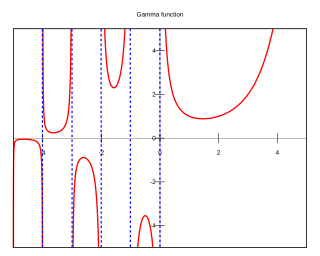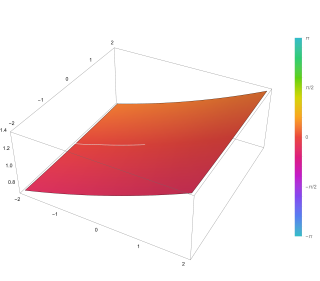Kummer's equation
Kummer's equation may be written as:

with a regular singular point at z = 0 and an irregular singular point at z = ∞. It has two (usually) linearly independent solutions M(a, b, z) and U(a, b, z).
Kummer's function of the first kind M is a generalized hypergeometric series introduced in ( Kummer 1837 ), given by:

where:


is the rising factorial. Another common notation for this solution is Φ(a, b, z). Considered as a function of a, b, or z with the other two held constant, this defines an entire function of a or z, except when b = 0, −1, −2, ... As a function of b it is analytic except for poles at the non-positive integers.
Some values of a and b yield solutions that can be expressed in terms of other known functions. See #Special cases. When a is a non-positive integer, then Kummer's function (if it is defined) is a generalized Laguerre polynomial.
Just as the confluent differential equation is a limit of the hypergeometric differential equation as the singular point at 1 is moved towards the singular point at ∞, the confluent hypergeometric function can be given as a limit of the hypergeometric function

and many of the properties of the confluent hypergeometric function are limiting cases of properties of the hypergeometric function.
Since Kummer's equation is second order there must be another, independent, solution. The indicial equation of the method of Frobenius tells us that the lowest power of a power series solution to the Kummer equation is either 0 or 1 − b. If we let w(z) be

then the differential equation gives

which, upon dividing out z1−b and simplifying, becomes

This means that z1−bM(a + 1 − b, 2 − b, z) is a solution so long as b is not an integer greater than 1, just as M(a, b, z) is a solution so long as b is not an integer less than 1. We can also use the Tricomi confluent hypergeometric function U(a, b, z) introduced by FrancescoTricomi ( 1947 ), and sometimes denoted by Ψ(a; b; z). It is a combination of the above two solutions, defined by

Although this expression is undefined for integer b, it has the advantage that it can be extended to any integer b by continuity. Unlike Kummer's function which is an entire function of z, U(z) usually has a singularity at zero. For example, if b = 0 and a ≠ 0 then Γ(a+1)U(a, b, z) − 1 is asymptotic to az ln z as z goes to zero. But see #Special cases for some examples where it is an entire function (polynomial).
Note that the solution z1−bU(a + 1 − b, 2 − b, z) to Kummer's equation is the same as the solution U(a, b, z), see #Kummer's transformation.
For most combinations of real or complex a and b, the functions M(a, b, z) and U(a, b, z) are independent, and if b is a non-positive integer, so M(a, b, z) doesn't exist, then we may be able to use z1−bM(a+1−b, 2−b, z) as a second solution. But if a is a non-positive integer and b is not a non-positive integer, then U(z) is a multiple of M(z). In that case as well, z1−bM(a+1−b, 2−b, z) can be used as a second solution if it exists and is different. But when b is an integer greater than 1, this solution doesn't exist, and if b = 1 then it exists but is a multiple of U(a, b, z) and of M(a, b, z) In those cases a second solution exists of the following form and is valid for any real or complex a and any positive integer b except when a is a positive integer less than b:

When a = 0 we can alternatively use:

When b = 1 this is the exponential integral E1(−z).
A similar problem occurs when a−b is a negative integer and b is an integer less than 1. In this case M(a, b, z) doesn't exist, and U(a, b, z) is a multiple of z1−bM(a+1−b, 2−b, z). A second solution is then of the form:

Other equations
Confluent Hypergeometric Functions can be used to solve the Extended Confluent Hypergeometric Equation whose general form is given as:
 [1]
[1]
Note that for M = 0 or when the summation involves just one term, it reduces to the conventional Confluent Hypergeometric Equation.
Thus Confluent Hypergeometric Functions can be used to solve "most" second-order ordinary differential equations whose variable coefficients are all linear functions of z, because they can be transformed to the Extended Confluent Hypergeometric Equation. Consider the equation:

First we move the regular singular point to 0 by using the substitution of A + Bz ↦ z, which converts the equation to:

with new values of C, D, E, and F. Next we use the substitution:

and multiply the equation by the same factor, obtaining:

whose solution is

where w(z) is a solution to Kummer's equation with

Note that the square root may give an imaginary or complex number. If it is zero, another solution must be used, namely

where w(z) is a confluent hypergeometric limit function satisfying

As noted below, even the Bessel equation can be solved using confluent hypergeometric functions.
Asymptotic behavior
If a solution to Kummer's equation is asymptotic to a power of z as z → ∞, then the power must be −a. This is in fact the case for Tricomi's solution U(a, b, z). Its asymptotic behavior as z → ∞ can be deduced from the integral representations. If z = x ∈ R, then making a change of variables in the integral followed by expanding the binomial series and integrating it formally term by term gives rise to an asymptotic series expansion, valid as x → ∞: [2]

where  is a generalized hypergeometric series with 1 as leading term, which generally converges nowhere, but exists as a formal power series in 1/x. This asymptotic expansion is also valid for complex z instead of real x, with |arg z| < 3π/2.
is a generalized hypergeometric series with 1 as leading term, which generally converges nowhere, but exists as a formal power series in 1/x. This asymptotic expansion is also valid for complex z instead of real x, with |arg z| < 3π/2.
The asymptotic behavior of Kummer's solution for large |z| is:

The powers of z are taken using −3π/2 < arg z ≤ π/2. [3] The first term is not needed when Γ(b − a) is finite, that is when b − a is not a non-positive integer and the real part of z goes to negative infinity, whereas the second term is not needed when Γ(a) is finite, that is, when a is a not a non-positive integer and the real part of z goes to positive infinity.
There is always some solution to Kummer's equation asymptotic to ezza−b as z → −∞. Usually this will be a combination of both M(a, b, z) and U(a, b, z) but can also be expressed as ez (−1)a-bU(b − a, b, −z).







































































